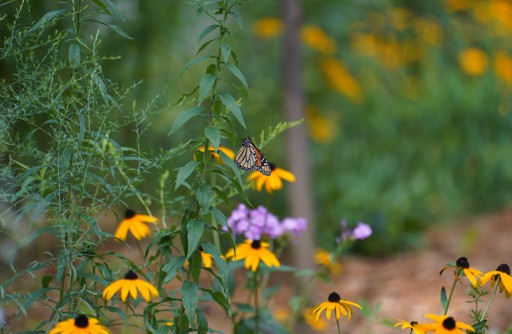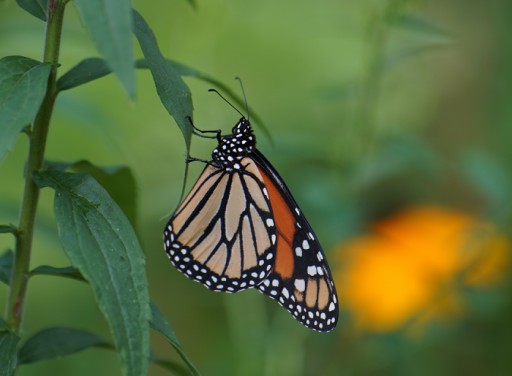I have grown common milkweed (and much less successfully swamp milkweed and butterfly weed, all members of the aesclepius family) for the monarchs for years; but I've seen far fewer of them this year: not surprising, as they're now endangered, which is not exactly a shining moment for that other species, homo sap.

Monarch butterfly in the front garden. 25aug22:09:51, Sony ILCE-7c, tamron 70–180mm lens (at 180mm) f/2.8, ev 0, 1/200s, iso 100. Cropped and scaled
In fact, I can only really recall seeing two, on consecutive days—the first was high, 20’ or more off the ground, and plainly booking it south for warmer climes; this one, on the following day, paused long enough to for me to grab the camera and photograph it.

closeup of same; 25aug22:09:51, Sony ILCE-7c, tamron 70–180mm lens (at 180mm) f/2.8, ev 0, 1/200s, iso 100. Cropped and scaled
I wondered if viceroy butterflies, which I was taught mimicked the monarchs because the latter taste bitter, were also in danger. A tasty insect copying an unpalatable one is called ‘Batesian mimicry.’ Turns out they're in the LC (least concern) category, but also that mimicry these butterflies carry out is quite a bit more complicated than I realized. Firstly, if both species taste nasty and copy each other, then it's Mullerian mimicry. With regard to viceroys, it's even more complicated than that, because their range overlaps not only with monarchs but other butterflies such as queens and soldiers (which are in the same genus and look very similar); and depending upon location, the viceroys may imitate either the monarchs, queens or soldiers![1]

viceroy butterfly, shot at a nearby wildlife refuge; 30jul22:08:09; google pixel pro 6, f/1.9, ev 0 1/1414s. 100% crop.
There's some controversy over which species are benefiting which, leading to speculation that the unpalatability of viceroys may vary with habitat and food sources.
As you can see in the photo above, they have fewer white spots along the edges of their wings, but the real giveaway is the black line in the lower wings.
[1]Actually, the monarchs, queens and soldiers are evidently also related to each other, and thus may even have had a similar mechanism when they genetically diverged for the three different patterns...
Unless otherwise noted, text, image and objects depicted therein copyright 1996--present sylvus tarn.
Sylvus Tarn